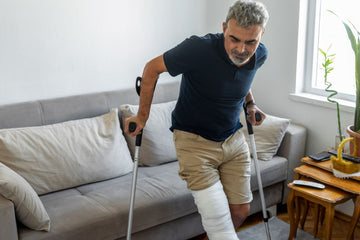Recovering at home—whether it’s from surgery, illness, or injury—isn't just about taking medication and resting. It’s also about the environment around you. And believe it or not, one of the most critical rooms in that healing journey might just be your living room.
Why? Because it's where life still happens. It’s the space where you catch up on favorite shows, sip tea, greet visitors, or simply stretch your legs. It’s often the most central and comfortable area of the home. And with just a few thoughtful tweaks, it can become a powerful ally in your recovery journey—offering not just convenience, but a sense of peace, autonomy, and emotional uplift.
This post is all about showing you how to create a cozy, supportive, and recovery-friendly living room—one that helps your body heal and your spirit stay strong.
1. Start with Comfort: Seating That Supports, Not Strains
Comfort is king—but comfort during recovery means more than just softness. You’ll want seating that promotes good posture and reduces strain on your lower back, legs, and joints.
High, Firm Seating: Consider chairs or sofas that are slightly firm and sit a bit higher. This makes getting up easier—especially for those dealing with mobility issues or knee and hip sensitivity.
Supportive Cushions: An Ergonomic Lumbar Support Pillow or Memory Foam Seat Cushion can work wonders for long hours of sitting, whether you’re watching TV or enjoying some quiet reading time. These supports promote spinal alignment and reduce pressure on sensitive areas.
Tip: Keep a lightweight blanket or shawl nearby to regulate temperature without needing to get up repeatedly.
2. Create a Mobility-Friendly Layout
A clutter-free space isn’t just more peaceful—it’s safer. Rearranging furniture slightly to allow wider walking paths can reduce the risk of tripping or falling.
Tuck Away Rugs: Area rugs may be cozy, but they can be a hazard when using walkers, rollators, or even just navigating on tired legs.
Stable Surfaces: Ensure that coffee tables and side tables are sturdy and easy to reach. Keep remotes, water bottles, medications, and tissues close at hand.
Bonus Tip: A small basket on a side table can help keep essentials in one spot without clutter.
3. Think Beyond Pain: Addressing the Emotional Side of Recovery
The living room is also your emotional recovery zone. It's where you'll likely spend a lot of alone time, and even small sensory experiences can improve your mood and mindset.
Aromatherapy Touches: A Premium Essential Oil Set paired with an Ultrasonic Essential Oil Diffuser can elevate the atmosphere and create a calming sensory environment. Lavender for relaxation, eucalyptus for clarity, or citrus for a gentle uplift—small aromas can bring big comfort.
Lighting Choices: Swap out harsh overhead lights for warm, soft table or floor lamps. Natural lighting, when available, is even better for mental wellness and regulating your sleep cycle.
A recovery space should feel safe, warm, and just a bit indulgent. You're doing something hard. You deserve a space that honors that.
4. Warmth and Circulation: Supporting Your Physical Needs
Maintaining proper circulation and temperature regulation is important during recovery—especially if you're less mobile or dealing with swelling and soreness.
Consider tools like an Air Compression Leg Massager for gently improving circulation in the lower legs, especially if you're sitting for long periods.
Or go for pure cozy comfort with an Electric Thick Heated Blanket—which provides soothing warmth, reduces muscle stiffness, and feels like a gentle hug.
5. Accessible Entertainment and Activity Options
A TV and a remote are recovery essentials, but don’t forget variety. Puzzle books, magazines, knitting, journaling, or sketching can all offer low-effort ways to stay engaged without physical strain.
Keep a small activity cart or side table nearby with your favorite books, chargers, or hobby materials. Recovery can be boring—but it doesn’t have to be.
Conclusion: Healing Happens at Home—Make It Work for You
The road to recovery can feel long, but creating a supportive living space is one of the simplest ways to make it a little smoother. A recovery-friendly living room is not about a fancy makeover. It's about intention. It’s about setting yourself (or your loved one) up for better rest, easier movement, and emotional ease.
Whether you're recovering from surgery, supporting a parent after a hospital stay, or just preparing for life’s curveballs, these thoughtful upgrades can truly transform your home into a healing haven.
Remember: healing isn’t just something you do—it's something your environment helps you with. And it all starts with the room where you live, laugh, and rest the most.







